Uzbekistan
Things to DO
Tashkent
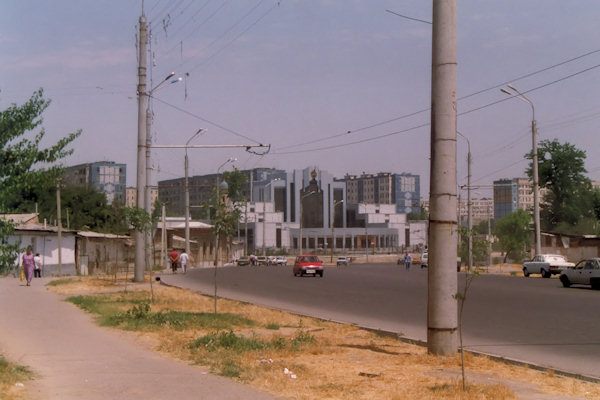 |
|||||
Tashkent, is the capital and largest city of Uzbekistan, as well as the most populous city in ex-Soviet Central Asia.
Before Islamic influence started in the mid 8th century AD, Tashkent was influenced by the Sogdian and Turkic cultures.
After Genghis Khan destroyed it in 1219, it was rebuilt and profited from the Silk Road.
From the 18th to the 19th century, the city became an independent city-state, before being re-conquered by the Khanate of Kokand.
In 1865, Tashkent fell to the Russian Empire, and became the capital of Russian Turkestan.
Much of Tashkent was destroyed in the 1966 Tashkent earthquake, but it was rebuilt as a model Soviet city.
The old town, a maze of narrow dirt streets, lined with low mud-brick houses and dotted with mosques and old medressas starts
beside the Chorsu bazar; Tashkent’s most famous farmers market, topped by a giant green dome.
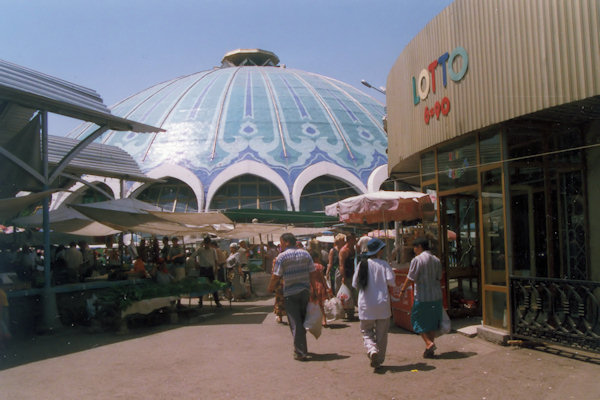 |
|||||
Kukeldash Madrasa is located on a high hill in the area of Chorsu square. The builder of the madrasah was a vezir of the Tashkent
khans (1551-1575), called Kukeldash ("the foster-brother of the khan").
The madrassah have repeatedly fallen into ruins. Tumbled by an earthquake in 1866 and 1886, the portal was then restored. It was renovated
in 1950-1960-1977 years.
Barakh-khan Madrasa was built in the XVI century by Suyunidzh-khan, an Ulugbek’s grandson. It is a known fact that became a
location of the Spiritual Administration of Muslims of Central Asia.
A special premise of the Barakh-khan Madrasah library is used to keep the world-known Koran of Caliph Osman. It is the primary
source of the holy Islam book written in the mid-VII century.
At the Amir Timur maydoni, a glowering bust of Marx has been replaced by a suitable patriotic statue of Timur om horseback.
The gardens and fountains around it are some of the nicest in the city.
Khiva
In the early part of its history, the inhabitants of the area came from Iranian stock and spoke an Eastern Iranian language called
Khwarezmian. Turks replaced the Iranian ruling-class in the 10th century A.D., and the region gradually turned into an area with
a majority of Turkic speakers.
The earliest records of the city of Khiva appear in Muslim travel accounts from the 10th century, although archaeological evidence
indicates habitation in the 6th century.
By the early 17th century, Khiva had become the capital of the Khanate of Khiva, ruled by a branch of the Astrakhans,
a Genghisid dynasty.
In the 17th century Khiva began to develop as a slave market. During the first half of the 19th century, around one million
Persians and an unknown number of Russians, were enslaved there before being sold.
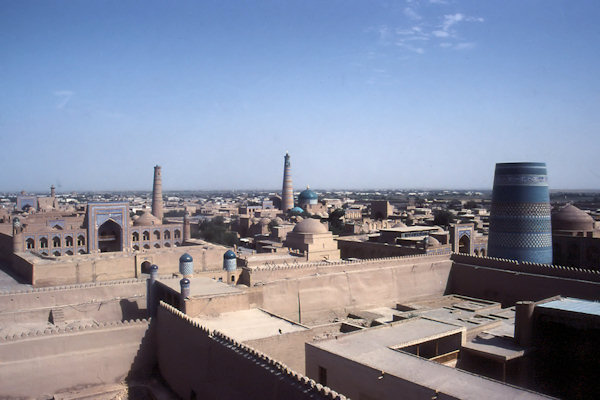 |
|||||
In the course of the Russian conquest of Central Asia, in 1873 the Russian General Konstantin von Kaufman launched an attack
on the city of Khiva, which fell on 28 May 1873.
Although the Russian Empire now controlled the Khanate, it allowed Khiva to remain as a nominally quasi-independent protectorate. It was
finally incorporated into the Soviet Union in 1924.
Khiva is an odd place. Its historic heart, unlike those of other Central Asian cities, is preserved in its entirely - but so
well preserved that the life has almost been squeezed out of it.
As a result of a Soviet conservation program in the 1970s and 80s, it's now a squeaky-clean official "city-museum"
Even among its densely packed mosques, tombs, palaces, alleys and at least 16 medressas, you need imagination to get a sense of its
mystique, bustle and squalor.
Remind yourself that in its heyday everything tended to be weedy, crowded and filthy.
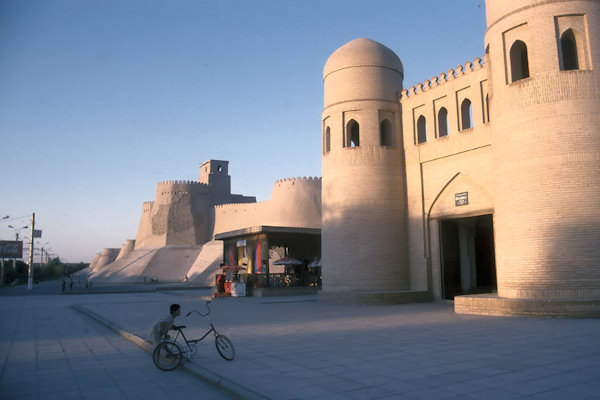 |
|||||
However, streets just a block or two away but still within the walled inner city, the Ichon-Qala remain lived in and fairly
dishevelled.
The main entrance to the Ichon-Qala is the twin-turreted brick West Gate (Ata-Darvaza literally "Father Gate"), a 1970s
reconstruction - the original was wrecked in 1920.
The picturesque 2,5km-long mud walls date from the 18th century, rebuilt after being wrecked by the Persians. The north-west sector has
been fully restored in recent decades; other streches are in a more tumble-down state.
The East Gate (Palvan-Darvaza; "Strong-man's Gate") is a long, vaulted 19th century passage with several sets of immense
carved doors. The slave market was held around here, and niches in the passage walls once held slaves for sale.
The walls als have a Nothern Gate (Bagcha-Darvaza; "Bukhara Gate"); a southern Gate (Tash-Darvaza; Stone Gate")
as well as about fourty bastions.
Kuhna Ark Fortress; originally built as early as the 12th century, the nucleus of its current layout was first constructed by
Arang Khan (r. 1688-94) but was largely razed in the 18th century Persian invasions. The present buildings are mainly the work
of Inaq Iltuzer
(r. 1804-06) and his immediate successors.
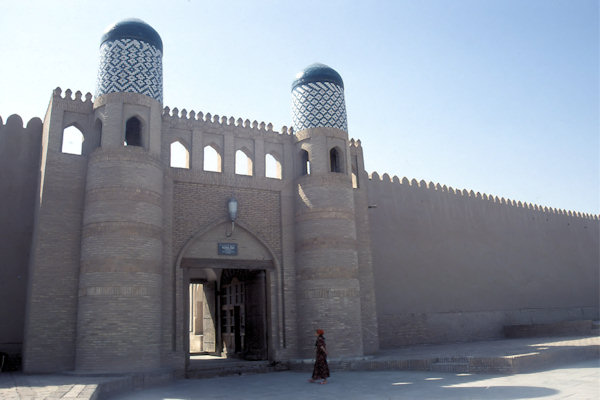 |
|||||
Iltuzer was the founder of the Qungrat dynasty which was to rule Khiva until the early 20th century when the city-state was
annexed as a Russian protectorate.
With an area of about 1.2 hectares, the Ark contained the Khan's palace, winter and summer mosques, a powder factory, mint, court,
workshops and warehouses, other buildings. Only parts have been restored.
The citadel has only one major entrance—an east-facing portal flanked by two cylindrical towers.
The Summer Mosque, built in 1838, is located immediately to the right of the main entrance and comprises a spacious north-facing
iwan clad in blue majolica tiles with a wooden roof accented in red, orange, yellow and gold.
The Reception Courtyard lies deeper into the ark and includes an iwan similar in appearance to that of the summer mosque.
Behind the iwan (to the south) is a Throne Room dating from 1804-06 which was used primarily in winter months.
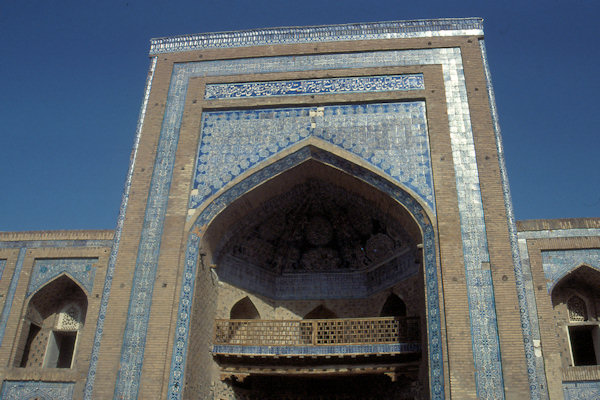 |
|||||
The Mohammed Rakhim Khan Madrasa occupies a prominent location opposite the Kuhna Ark. It was commissioned in 1871, just prior
to the absorption of Khiva by Russia in 1873, and was completed by 1876.
As the Khan was a ruler with one foot in the historical traditions of the Khiva Khanate, and the other foot in what promised to be a
Russian-dominated future, the madrasa taught not only traditional Islamic studies but also secular subjects such as astronomy, geography,
and mathematics.
During the rule of Allakuli Khan (1794-1842), the center of the state, public and commercial life of the city moved to the eastern
part of Ichan-Kala. Here at the gates of Palvan-Darvaz a whole complex of new buildings was built, the new Khan Palace of Tash-Khovli,
a madrasah, a caravanserai and a commercial dome center.
Only parts of the buildings are open for tourists.
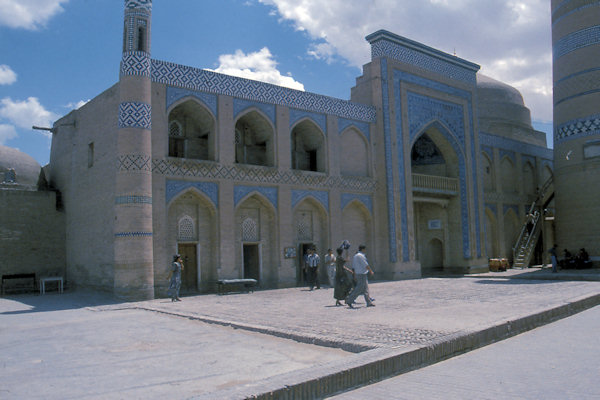 |
|||||
The Islam-Khodja complex stands to the southeast of the main east-west street in Khiva's Ichan-Kala (old city) and
includes a madrasa and minaret.
The site is named after Islam Khodja, the grand vizier (and also first cousin) of Muhammad Rahmi Bahadur II, the ruler of the
Khanate of Khiva from 1864-1910.
Pahlavan Mahmud was an Iranian poet and wrestler who lived from 1247-1326. Although he was not strictly a religious figure, his
tomb became a popular place of pilgrimage.
Over many decades, the area to the north, west, and east of Mahmud's tomb grew into a cemetery for the city's elite. Although most of
these small tombs are of little architectural interest, they do suggest that proximity to Mahmud's tomb was desirable for those able to
obtain plots in the dense heart of the Ichan-Kala.